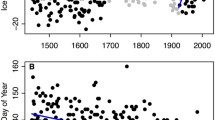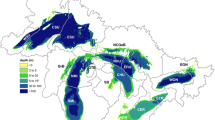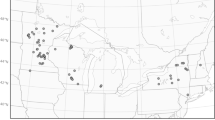Abstract
Historical ice records, such as freeze and breakup dates and the total duration of ice cover, can be used as a quantitative indicator of climatic change if long homogeneous records exist and if the records can be calibrated in terms of climatic changes. Lake Mendota, Wisconsin, has the longest uninterrupted ice records available for any lake in North America dating back to 1855. These records extend back prior to any reliable air temperature data in the midwestern region of the U.S. and demonstrate significant warming of approximately 1.5 °C in fall and early winter temperatures and 2.5 °C in winter and spring temperatures during the past 135 years. These changes are not completely monotonie, but rather appear as two shorter periods of climatic change in the longer record. The first change was between 1875 and 1890, when fall, winter, and spring air temperatures increased by approximately 1.5 °C. The second change, earlier ice breakup dates since 1979, was caused by a significant increase in winter and early spring air temperatures of approximately 1.3 °C. This change may be indicative of shifts in regional climatic patterns associated with global warming, possibly associated with the ‘Greenhouse Effect’.
With the relationships between air temperature and freeze and break up dates, we can project how the ice cover of Lake Mendota should respond to future climatic changes. If warming occurs, the ice cover for Lake Mendota should decrease approximately 11 days per 1 °C increase. With a warming of 4 to 5 °C, years with no ice cover should occur in approximately 1 out of 15 to 30 years.
Similar content being viewed by others
References
Bauer, K. C. and Dutton, J. A.: 1960, ‘Flight Investigations of Surface Albedo’, Technical Report No. 2, Department of Meteorology, University of Wisconsin-Madison, Wisc.
Bilello, M. A.: 1964, ‘Method for Predicting River and Lake Ice Formation’, J. Appl. Meteor. 3, 38–44.
Box, G. and Tiao, G.: 1975, ‘Intervention Analysis with Application to Economic and Environmental Problems’, J. Amer. Stat. Ass. 29, 193–204.
Bunge, W. W. Jr. and Bryson, R. A.: 1956, ‘Ice on Wisconsin Lakes, Part 3’, Report to the University of Wisconsin Lake Investigation Committee No. 14, The University of Wisconsin, Department of Meteorology, Madison.
Dutton, J. A. and Bryson, R. A.: 1962, ‘Heat Flux in Lake Mendota’, Limn. & Oceanogr. 7, 80–97.
Gaskill, D. W.: 1981, ‘Homogeneity Analysis of Seasonal Mean Temperature Series at 25 Stations Around the Great Lakes’, NOAA Data Report ERL GLERL-18, Great Lakes Environmental Research Laboratory, Ann Arbor, Mich.
Hansen, J. and Lebedeff, S.: 1987, ‘Global Trends of Measured Surface Air Temperature’, J. Geophys. Res. 92, 13345–13372.
Juday, C.: 1940, ‘The Annual Energy Budget of an Inland Lake’, Ecology 21 (4), 438–450.
Karl, T. R. and Williams, C. N. Jr.: 1987, ‘An Approach to Adjusting Climatological Time Series for Discontinuous Inhomogeneities’, J. Clim. Appl. Meteor. 26, 1744–1763.
Lamb, H. H.: 1977, Climate: Present, Past, and Future. Volume 2. Climate History and the Future, Methuen Pub., London, England.
Liss, P. S. and Crane, A. J.: 1983, Man-made Carbon Dioxide and Climatic Change: A Review of Scientific Problems, GeoBooks Pub., Norwich, England, 125 pp.
McFadden, J. D.: 1965, ‘The Interrelationship of Lake Ice and Climate in Central Canada’, Technological Report No. 20, Department of Meteorology, University of Wisconsin-Madison, Wisc.
Neese, J. C. and Bunge, W. W. Jr.: 1956, ‘An Unpublished Manuscript of E. A. Birge on the Temperature of Lake Mendota: Part I’, Trans. Wis. Acad. Sci., Arts, and Letters 45, 193–238.
O'Neill, R.: 1971, ‘Algorithm 47. Function Minimization Using a Simplex Procedure’, Appl. Sci. 20, 338–345.
Palecki, M. A. and Barry, R. G.: 1986, ‘Freeze-up and Break-up of Lakes as an Index of Temperature Change During the Transition Seasons: A Case Study for Finland’, J. Clim. Appl. Meteor. 25, 893902.
Ragotzkie, R. A.: 1978, ‘Heat Budgets of Lakes’, in: Lehrman, A. (ed.), Lakes: Chemistry, Biology, and Physics, Springer-Verlag, New York, NY, pp. 1–18.
Ramanathan, V.: 1988, ‘The Greenhouse Theory of Climate Change. A Test by an Inadvertent Global Experiment’, Science 240, 293–299.
Rannie, W. F.: 1983, ‘Break Up and Freeze Up of the Red River at Winnepeg, Manitoba Canada in the 19th Century and Some Climatic Implications’, Climatic Change 5, 283–296.
Rodhe, B.: 1952, ‘On the Relation between Air Temperature and Ice Formation in the Baltic’, Geografiska annaler 34, 175–202.
Robertson, D. M.: 1989, ‘The Use of Lake Water Temperature and Ice Cover as Climatic Indicators’, Ph.D. Thesis, Ocean. and Limn. Graduate program, University of Wisconsin-Madison, Wisc.
Schaal, L. A. and Dale, R. F.: 1977, ‘Time of Observation Temperature Bias and “Climate Change”’, J. Appl. Meteor. 16, 215–222.
Scott, J. T. and Ragotzkie, R. A.: 1961, ‘Heat Budget of an Ice Covered Inland Lake’, Technological Report No. 6, Department of Meteorology, University of Wisconsin-Madison, Wisc.
Sellers, W. D.: 1974, Physical Climatology, University of Chicago Press, Chicago, Ill., 272 pp.
Tramoni, F.: 1985, ‘Lake Ice Occurrence as a Climatic Indicator in Studies of Carbon Dioxide Induced Warming: A Canadian Case Study’, M.S. Thesis, Department of Geography, University of Colorado-Boulder, Colo.
Tramoni, F., Barry, R. G., Key, J.: 1985, ‘Lake Ice Cover as a Temperature Index for Monitoring Climate Perturbations’, Zeitschrift für Gletscherkunde und Glazialgeologie 21, 43–49.
Wahl, E. W. and Lawson, T. L.: 1970, ‘The Climate of the Nineteenth Century United States Compared to the Current Normals’, Mon. Weather Rev. 98 (4), 259–264.
Williams, G. P.: 1965, ‘Correlating Freeze-up and Break-up with Weather Conditions’, Canadian Geotechn. J. II, 313–326.
Author information
Authors and Affiliations
Rights and permissions
About this article
Cite this article
Robertson, D.M., Ragotzkie, R.A. & Magnuson, J.J. Lake ice records used to detect historical and future climatic changes. Climatic Change 21, 407–427 (1992). https://doi.org/10.1007/BF00141379
Received:
Revised:
Issue Date:
DOI: https://doi.org/10.1007/BF00141379




